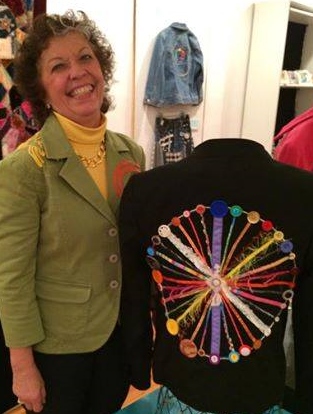My inner dialogue with my SoulShirt™ continues.
This is the conclusion of my current blog series on Creative and Contemplative Handwork™ – making things with our hands that represent and facilitate our inner process. We pick up the thread from
last week’s post with my inner dialogue:
“Ripping stitches out and starting over will take too much time. I don’t have that much time. I had planned to be

far ahead of this by now. I hate this. Gary will show up again any minute, and I will bite his head off for sure. And if I keep ripping stitches out, the fabric will be mangled and I’ll have to start over. Oh well, I have the fabric for it if that’s necessary.” I had kept ripping stitches during this inner argument. Now I notice that the mistakes are almost all ripped out and the fabric isn’t ruined after all.
I think of the Amish and how they purposely put one mistake into every creative project to remind themselves that they are not God. “Well, I’ll never have to do that. I have more mistakes than anything else.”
“
Remember Thomas Edison, who found 10,000 ways that don’t work to build a light bulb?” the tiny, quiet voice within whispered to me.
“OK, so far, I’ve found four ways that don’t work to make this circle of fabric. Time to start round number five. I also need to replenish the chalk lines- I can’t see the ones I started with.” I responded. I re-chalked the circle, found a different way to pin on the fabric strips and then began stitching─this time with a different pressure foot and going so slowly that only one stitch at a time showed up. Voilà! It worked this time. “It’s not a perfect circle, but it’s close enough. There’s nothing horrible catching my eye. There’s nothing that I will cringe at when I wear this. Whew!” I thought.
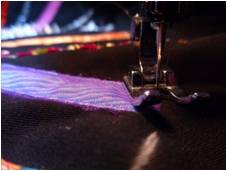 I found myself thinking about how sewing involves taking a needle,
I found myself thinking about how sewing involves taking a needle, drawing a thread through it, and using the needle and thread to bring together two or more separate pieces of fabric or material. When I sew, I take the needle, whether I’m sewing by machine or by hand, and make the needle poke a hole in the fabric not once, but twice for each stitch. The needle and thread pierce the fabric as they go down and then again as they come back up.
This seems to be a perfect metaphor for connecting our conscious and unconscious minds. Going down to connect with the Unconscious can poke holes in our illusions, our defenses, or whatever is in the way of our lives. Coming up with something provided for us by the Unconscious can also poke holes our consciousness─ sometimes in the same places that were poked on the way down. At other times, the holes appear in completely new places.
These holes are the places in us that need to open up so our inner lives can be stitched together.
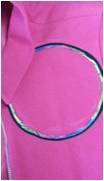 Now my reflections take a different turn.
“What is it that’s so different about this kind of project
Now my reflections take a different turn.
“What is it that’s so different about this kind of project that I can persist here, but with so many other things in my life, as soon as there are challenges or setbacks, I take it as proof that I’m not supposed to be doing [whatever it is], and (even though it doesn’t happen) I also keep expecting God to give me directions to do something else?
I continued the internal dialogue, “How is it that I can keep the vision of this currently unfinished project in my mind and yet for things which are less tangible, but seem more important to my life as a whole, a vision of the end result often seems to elude me? Or sometimes it’s there, and sometimes it’s not? Hmm . . . . maybe the fact that when challenges and setbacks come, I can’t always stay visually connected with my goals may not have the meaning that I have assumed. Maybe if I approach these other goals the way I do this creative project, I could have more successful outcomes in other areas of my life as well.
This is so obvious now; why did it take wandering about with fabric and stitches to discover this?”
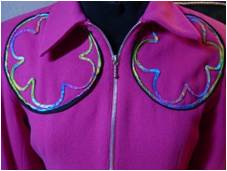 Once again, I realized that the power of the process
Once again, I realized that the power of the process of Creative and Contemplative Handwork™ could help me make connections between my inner and outer life, to help get me over a hurdle,
to bring me a deep awareness that had been eluding me and that is crucial to my life.
Again, I discover that by ‘playing around’ in a low risk activity, I learn something which can be applied in a much higher risk area of my life, to my advantage.
I accessed the deep wisdom I (sort of) knew was there, but with which I hadn’t been able to connect.
I am awed and humbled again and again as I understand that as I pursue the seemingly frivolous it is then and only then that I am able to learn profound life lessons that have eluded me for quite some time.
You can too.
But How?
With Creative Handwork, the goal is to make something that shows and demonstrates the emotions you are feeling, not to make something that is technically or artistically ‘correct’. This is personal art, not necessarily fine art. Sometimes the two merge, but here
the purpose is self-expression, and the thought of what it might look like to others needs to be banished, so you can be free to reach deep within and bring out what is aching to be expressed but has no words, only images.
How can you do this? One way is to draw with your non-dominant hand and even close your eyes while you do it. Your non-dominant hand is directly connected to your emotions and your psyche, and bypasses the inner critic more easily than your dominant hand.
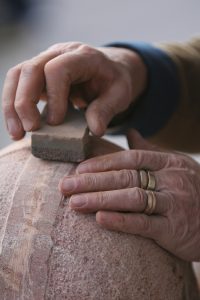 Another way is to pay attention to the pictures or images that show up in your mind’s eye. You can then make something that brings the inner image into concrete form.
Another way is to pay attention to the pictures or images that show up in your mind’s eye. You can then make something that brings the inner image into concrete form. You can use any art of craft medium that is accessible to you, including simple crayon drawings. the medium you use does not matter, except that it is something that is available to you and possible for you to use.
Again, the purpose of this is not to “make art” but to bring the image(s) that show up for you or come to you, out into the light of day and follow the inner process to discover the message and meaning it brings to you.
When you allow the playful, rhythmic motions of your hands to produce a meditative state within, and follow your stream of thoughts, an inner dialogue can develop. Your Creative Handwork can then become Contemplative Handwork: the craft or art speaks its deep wisdom back to you.
Research by Dr Jacques Hadamard (The Psychology of Invention in the mathematical Field) found that the working methods of many great scientists involved starting with visual images that they saw in their mind’s eye, not with language or mathematical symbols. In this book, he describes how Albert Einstein had a process of working/playing with visual images first, and later translating them into words. He called it “combinatory play” and used it to develop all of his breakthrough ideas. Edison went fishing when he was fishing for great ideas.
This same process is equally powerful when applied to personal growth and healing.
When you contemplate what you are making, or have made, you see what is there is to see. You
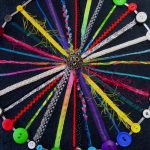
observe the colors, shapes, textures, hues, color values. You also notice what happens inside of you as you look. You pay attention to where your mind wanders, to your body sensations, to anything that occurs internally. You also look
through what you have made, into the space ‘between’. You allow similarities, connections and patterns to emerge. You look with the third eye and listen with the inner ear. What do you hear? Sounds? Words? Music? Silence? Flowers growing?
Bringing out your deep emotion and the images connected with it builds a bridge to your unconscious, where your inner wisdom often hides out. When you see with the third eye and listen with the inner ear, your deep inner wisdom comes back out over that same bridge. In addition, as you work with these images, they transform,move and shift. Your energy transforms, moves and shifts at the same time, as do your ideas and imagination about you and your life situation.
It’s important to record what you see and hear and to translate the message(s) that it seems to bring to you into words or music or whatever is relevant, available, accessible to you. These messages are often hard for us to ‘hear’, to take in and remember. Making notes while you are doing this, and later going back to flesh them out, is crucial to bringing the new insights or perspectives that have come to you across the threshold from the realm of imagination into the often cruel, harsh light of day.
The final step is to translate this into action – what action is implied here? What is it that you need to DO in order to bring this often deeply spiritual message and connect it with matter? What practical, nitty gritty thing(s) need to be done in order to embody this? And HOW is it that this can be done? Without this final step, all of this stays in the realm of the intangible, AKA never-never land. For intuitive people, this final step can be excruciatingly difficult. For practical, sensate people, the imaginative part of this can be excruciatingly difficult.
For completion, we need to bring both of these together and bring what has come to you across the threshold from never-never land into our everyday lives.
Through Creative Handwork and Contemplative Handwork, you can experience and even facilitate Positive Disintegration, as described by Dabrowski. You can see the chaos in the images you have made transform into order as you work with them. You can see and feel your own energy transform along with the images. It is as you participate in creation in this way, that you begin to experience on a deep visceral level the energy concealed in matter, and grasp what it is to harvest the seed of benefit hidden deep within adversity.
Using Creative Handwork and Contemplative Handwork can be a deeply nourishing, fun, gentle way of facilitating your own healing, growth and transformation.
 far ahead of this by now. I hate this. Gary will show up again any minute, and I will bite his head off for sure. And if I keep ripping stitches out, the fabric will be mangled and I’ll have to start over. Oh well, I have the fabric for it if that’s necessary.” I had kept ripping stitches during this inner argument. Now I notice that the mistakes are almost all ripped out and the fabric isn’t ruined after all.
I think of the Amish and how they purposely put one mistake into every creative project to remind themselves that they are not God. “Well, I’ll never have to do that. I have more mistakes than anything else.”
“Remember Thomas Edison, who found 10,000 ways that don’t work to build a light bulb?” the tiny, quiet voice within whispered to me.
“OK, so far, I’ve found four ways that don’t work to make this circle of fabric. Time to start round number five. I also need to replenish the chalk lines- I can’t see the ones I started with.” I responded. I re-chalked the circle, found a different way to pin on the fabric strips and then began stitching─this time with a different pressure foot and going so slowly that only one stitch at a time showed up. Voilà! It worked this time. “It’s not a perfect circle, but it’s close enough. There’s nothing horrible catching my eye. There’s nothing that I will cringe at when I wear this. Whew!” I thought.
far ahead of this by now. I hate this. Gary will show up again any minute, and I will bite his head off for sure. And if I keep ripping stitches out, the fabric will be mangled and I’ll have to start over. Oh well, I have the fabric for it if that’s necessary.” I had kept ripping stitches during this inner argument. Now I notice that the mistakes are almost all ripped out and the fabric isn’t ruined after all.
I think of the Amish and how they purposely put one mistake into every creative project to remind themselves that they are not God. “Well, I’ll never have to do that. I have more mistakes than anything else.”
“Remember Thomas Edison, who found 10,000 ways that don’t work to build a light bulb?” the tiny, quiet voice within whispered to me.
“OK, so far, I’ve found four ways that don’t work to make this circle of fabric. Time to start round number five. I also need to replenish the chalk lines- I can’t see the ones I started with.” I responded. I re-chalked the circle, found a different way to pin on the fabric strips and then began stitching─this time with a different pressure foot and going so slowly that only one stitch at a time showed up. Voilà! It worked this time. “It’s not a perfect circle, but it’s close enough. There’s nothing horrible catching my eye. There’s nothing that I will cringe at when I wear this. Whew!” I thought.
 I found myself thinking about how sewing involves taking a needle, drawing a thread through it, and using the needle and thread to bring together two or more separate pieces of fabric or material. When I sew, I take the needle, whether I’m sewing by machine or by hand, and make the needle poke a hole in the fabric not once, but twice for each stitch. The needle and thread pierce the fabric as they go down and then again as they come back up.
This seems to be a perfect metaphor for connecting our conscious and unconscious minds. Going down to connect with the Unconscious can poke holes in our illusions, our defenses, or whatever is in the way of our lives. Coming up with something provided for us by the Unconscious can also poke holes our consciousness─ sometimes in the same places that were poked on the way down. At other times, the holes appear in completely new places. These holes are the places in us that need to open up so our inner lives can be stitched together.
I found myself thinking about how sewing involves taking a needle, drawing a thread through it, and using the needle and thread to bring together two or more separate pieces of fabric or material. When I sew, I take the needle, whether I’m sewing by machine or by hand, and make the needle poke a hole in the fabric not once, but twice for each stitch. The needle and thread pierce the fabric as they go down and then again as they come back up.
This seems to be a perfect metaphor for connecting our conscious and unconscious minds. Going down to connect with the Unconscious can poke holes in our illusions, our defenses, or whatever is in the way of our lives. Coming up with something provided for us by the Unconscious can also poke holes our consciousness─ sometimes in the same places that were poked on the way down. At other times, the holes appear in completely new places. These holes are the places in us that need to open up so our inner lives can be stitched together.
 Now my reflections take a different turn.
“What is it that’s so different about this kind of project that I can persist here, but with so many other things in my life, as soon as there are challenges or setbacks, I take it as proof that I’m not supposed to be doing [whatever it is], and (even though it doesn’t happen) I also keep expecting God to give me directions to do something else?
I continued the internal dialogue, “How is it that I can keep the vision of this currently unfinished project in my mind and yet for things which are less tangible, but seem more important to my life as a whole, a vision of the end result often seems to elude me? Or sometimes it’s there, and sometimes it’s not? Hmm . . . . maybe the fact that when challenges and setbacks come, I can’t always stay visually connected with my goals may not have the meaning that I have assumed. Maybe if I approach these other goals the way I do this creative project, I could have more successful outcomes in other areas of my life as well. This is so obvious now; why did it take wandering about with fabric and stitches to discover this?”
Now my reflections take a different turn.
“What is it that’s so different about this kind of project that I can persist here, but with so many other things in my life, as soon as there are challenges or setbacks, I take it as proof that I’m not supposed to be doing [whatever it is], and (even though it doesn’t happen) I also keep expecting God to give me directions to do something else?
I continued the internal dialogue, “How is it that I can keep the vision of this currently unfinished project in my mind and yet for things which are less tangible, but seem more important to my life as a whole, a vision of the end result often seems to elude me? Or sometimes it’s there, and sometimes it’s not? Hmm . . . . maybe the fact that when challenges and setbacks come, I can’t always stay visually connected with my goals may not have the meaning that I have assumed. Maybe if I approach these other goals the way I do this creative project, I could have more successful outcomes in other areas of my life as well. This is so obvious now; why did it take wandering about with fabric and stitches to discover this?”
 Once again, I realized that the power of the process of Creative and Contemplative Handwork™ could help me make connections between my inner and outer life, to help get me over a hurdle, to bring me a deep awareness that had been eluding me and that is crucial to my life.
Again, I discover that by ‘playing around’ in a low risk activity, I learn something which can be applied in a much higher risk area of my life, to my advantage.
I accessed the deep wisdom I (sort of) knew was there, but with which I hadn’t been able to connect.
I am awed and humbled again and again as I understand that as I pursue the seemingly frivolous it is then and only then that I am able to learn profound life lessons that have eluded me for quite some time.
You can too.
But How?
With Creative Handwork, the goal is to make something that shows and demonstrates the emotions you are feeling, not to make something that is technically or artistically ‘correct’. This is personal art, not necessarily fine art. Sometimes the two merge, but here the purpose is self-expression, and the thought of what it might look like to others needs to be banished, so you can be free to reach deep within and bring out what is aching to be expressed but has no words, only images.
How can you do this? One way is to draw with your non-dominant hand and even close your eyes while you do it. Your non-dominant hand is directly connected to your emotions and your psyche, and bypasses the inner critic more easily than your dominant hand.
Once again, I realized that the power of the process of Creative and Contemplative Handwork™ could help me make connections between my inner and outer life, to help get me over a hurdle, to bring me a deep awareness that had been eluding me and that is crucial to my life.
Again, I discover that by ‘playing around’ in a low risk activity, I learn something which can be applied in a much higher risk area of my life, to my advantage.
I accessed the deep wisdom I (sort of) knew was there, but with which I hadn’t been able to connect.
I am awed and humbled again and again as I understand that as I pursue the seemingly frivolous it is then and only then that I am able to learn profound life lessons that have eluded me for quite some time.
You can too.
But How?
With Creative Handwork, the goal is to make something that shows and demonstrates the emotions you are feeling, not to make something that is technically or artistically ‘correct’. This is personal art, not necessarily fine art. Sometimes the two merge, but here the purpose is self-expression, and the thought of what it might look like to others needs to be banished, so you can be free to reach deep within and bring out what is aching to be expressed but has no words, only images.
How can you do this? One way is to draw with your non-dominant hand and even close your eyes while you do it. Your non-dominant hand is directly connected to your emotions and your psyche, and bypasses the inner critic more easily than your dominant hand.
 Another way is to pay attention to the pictures or images that show up in your mind’s eye. You can then make something that brings the inner image into concrete form. You can use any art of craft medium that is accessible to you, including simple crayon drawings. the medium you use does not matter, except that it is something that is available to you and possible for you to use. Again, the purpose of this is not to “make art” but to bring the image(s) that show up for you or come to you, out into the light of day and follow the inner process to discover the message and meaning it brings to you.
When you allow the playful, rhythmic motions of your hands to produce a meditative state within, and follow your stream of thoughts, an inner dialogue can develop. Your Creative Handwork can then become Contemplative Handwork: the craft or art speaks its deep wisdom back to you.
Research by Dr Jacques Hadamard (The Psychology of Invention in the mathematical Field) found that the working methods of many great scientists involved starting with visual images that they saw in their mind’s eye, not with language or mathematical symbols. In this book, he describes how Albert Einstein had a process of working/playing with visual images first, and later translating them into words. He called it “combinatory play” and used it to develop all of his breakthrough ideas. Edison went fishing when he was fishing for great ideas. This same process is equally powerful when applied to personal growth and healing.
When you contemplate what you are making, or have made, you see what is there is to see. You
Another way is to pay attention to the pictures or images that show up in your mind’s eye. You can then make something that brings the inner image into concrete form. You can use any art of craft medium that is accessible to you, including simple crayon drawings. the medium you use does not matter, except that it is something that is available to you and possible for you to use. Again, the purpose of this is not to “make art” but to bring the image(s) that show up for you or come to you, out into the light of day and follow the inner process to discover the message and meaning it brings to you.
When you allow the playful, rhythmic motions of your hands to produce a meditative state within, and follow your stream of thoughts, an inner dialogue can develop. Your Creative Handwork can then become Contemplative Handwork: the craft or art speaks its deep wisdom back to you.
Research by Dr Jacques Hadamard (The Psychology of Invention in the mathematical Field) found that the working methods of many great scientists involved starting with visual images that they saw in their mind’s eye, not with language or mathematical symbols. In this book, he describes how Albert Einstein had a process of working/playing with visual images first, and later translating them into words. He called it “combinatory play” and used it to develop all of his breakthrough ideas. Edison went fishing when he was fishing for great ideas. This same process is equally powerful when applied to personal growth and healing.
When you contemplate what you are making, or have made, you see what is there is to see. You  observe the colors, shapes, textures, hues, color values. You also notice what happens inside of you as you look. You pay attention to where your mind wanders, to your body sensations, to anything that occurs internally. You also look through what you have made, into the space ‘between’. You allow similarities, connections and patterns to emerge. You look with the third eye and listen with the inner ear. What do you hear? Sounds? Words? Music? Silence? Flowers growing?
Bringing out your deep emotion and the images connected with it builds a bridge to your unconscious, where your inner wisdom often hides out. When you see with the third eye and listen with the inner ear, your deep inner wisdom comes back out over that same bridge. In addition, as you work with these images, they transform,move and shift. Your energy transforms, moves and shifts at the same time, as do your ideas and imagination about you and your life situation.
It’s important to record what you see and hear and to translate the message(s) that it seems to bring to you into words or music or whatever is relevant, available, accessible to you. These messages are often hard for us to ‘hear’, to take in and remember. Making notes while you are doing this, and later going back to flesh them out, is crucial to bringing the new insights or perspectives that have come to you across the threshold from the realm of imagination into the often cruel, harsh light of day.
The final step is to translate this into action – what action is implied here? What is it that you need to DO in order to bring this often deeply spiritual message and connect it with matter? What practical, nitty gritty thing(s) need to be done in order to embody this? And HOW is it that this can be done? Without this final step, all of this stays in the realm of the intangible, AKA never-never land. For intuitive people, this final step can be excruciatingly difficult. For practical, sensate people, the imaginative part of this can be excruciatingly difficult. For completion, we need to bring both of these together and bring what has come to you across the threshold from never-never land into our everyday lives.
Through Creative Handwork and Contemplative Handwork, you can experience and even facilitate Positive Disintegration, as described by Dabrowski. You can see the chaos in the images you have made transform into order as you work with them. You can see and feel your own energy transform along with the images. It is as you participate in creation in this way, that you begin to experience on a deep visceral level the energy concealed in matter, and grasp what it is to harvest the seed of benefit hidden deep within adversity. Using Creative Handwork and Contemplative Handwork can be a deeply nourishing, fun, gentle way of facilitating your own healing, growth and transformation.
observe the colors, shapes, textures, hues, color values. You also notice what happens inside of you as you look. You pay attention to where your mind wanders, to your body sensations, to anything that occurs internally. You also look through what you have made, into the space ‘between’. You allow similarities, connections and patterns to emerge. You look with the third eye and listen with the inner ear. What do you hear? Sounds? Words? Music? Silence? Flowers growing?
Bringing out your deep emotion and the images connected with it builds a bridge to your unconscious, where your inner wisdom often hides out. When you see with the third eye and listen with the inner ear, your deep inner wisdom comes back out over that same bridge. In addition, as you work with these images, they transform,move and shift. Your energy transforms, moves and shifts at the same time, as do your ideas and imagination about you and your life situation.
It’s important to record what you see and hear and to translate the message(s) that it seems to bring to you into words or music or whatever is relevant, available, accessible to you. These messages are often hard for us to ‘hear’, to take in and remember. Making notes while you are doing this, and later going back to flesh them out, is crucial to bringing the new insights or perspectives that have come to you across the threshold from the realm of imagination into the often cruel, harsh light of day.
The final step is to translate this into action – what action is implied here? What is it that you need to DO in order to bring this often deeply spiritual message and connect it with matter? What practical, nitty gritty thing(s) need to be done in order to embody this? And HOW is it that this can be done? Without this final step, all of this stays in the realm of the intangible, AKA never-never land. For intuitive people, this final step can be excruciatingly difficult. For practical, sensate people, the imaginative part of this can be excruciatingly difficult. For completion, we need to bring both of these together and bring what has come to you across the threshold from never-never land into our everyday lives.
Through Creative Handwork and Contemplative Handwork, you can experience and even facilitate Positive Disintegration, as described by Dabrowski. You can see the chaos in the images you have made transform into order as you work with them. You can see and feel your own energy transform along with the images. It is as you participate in creation in this way, that you begin to experience on a deep visceral level the energy concealed in matter, and grasp what it is to harvest the seed of benefit hidden deep within adversity. Using Creative Handwork and Contemplative Handwork can be a deeply nourishing, fun, gentle way of facilitating your own healing, growth and transformation.

